Accounting for Managers Assignment: Financial Ratio Analysis Report
VerifiedAdded on 2023/06/08
|10
|1921
|327
Report
AI Summary
This report presents a comprehensive financial analysis of Cash Converters International Ltd (CCV), covering the period from 2013 to 2017. The analysis begins with a horizontal analysis of the income statement, examining revenue, cost of revenue, operating expenses, and net income trends to identify key changes and performance drivers. The report then delves into profitability ratios, including operating profit margin and gross profit margin, to assess CCV's ability to generate earnings relative to its expenses. Efficiency ratios, such as inventory turnover and debtor turnover periods, are calculated to evaluate the company's asset and liability management. Liquidity ratios, including the current and quick ratios, are used to assess CCV's ability to meet its short-term obligations. Financial gearing ratios, like debt to total assets and interest coverage ratio, are calculated to determine the extent to which CCV uses debt financing. Finally, investment ratios, including price-earnings ratio and dividend yield, are analyzed to evaluate the company's performance from an investor's perspective. The report uses data from CCV's annual reports and provides insights into the company's financial health and key performance indicators.
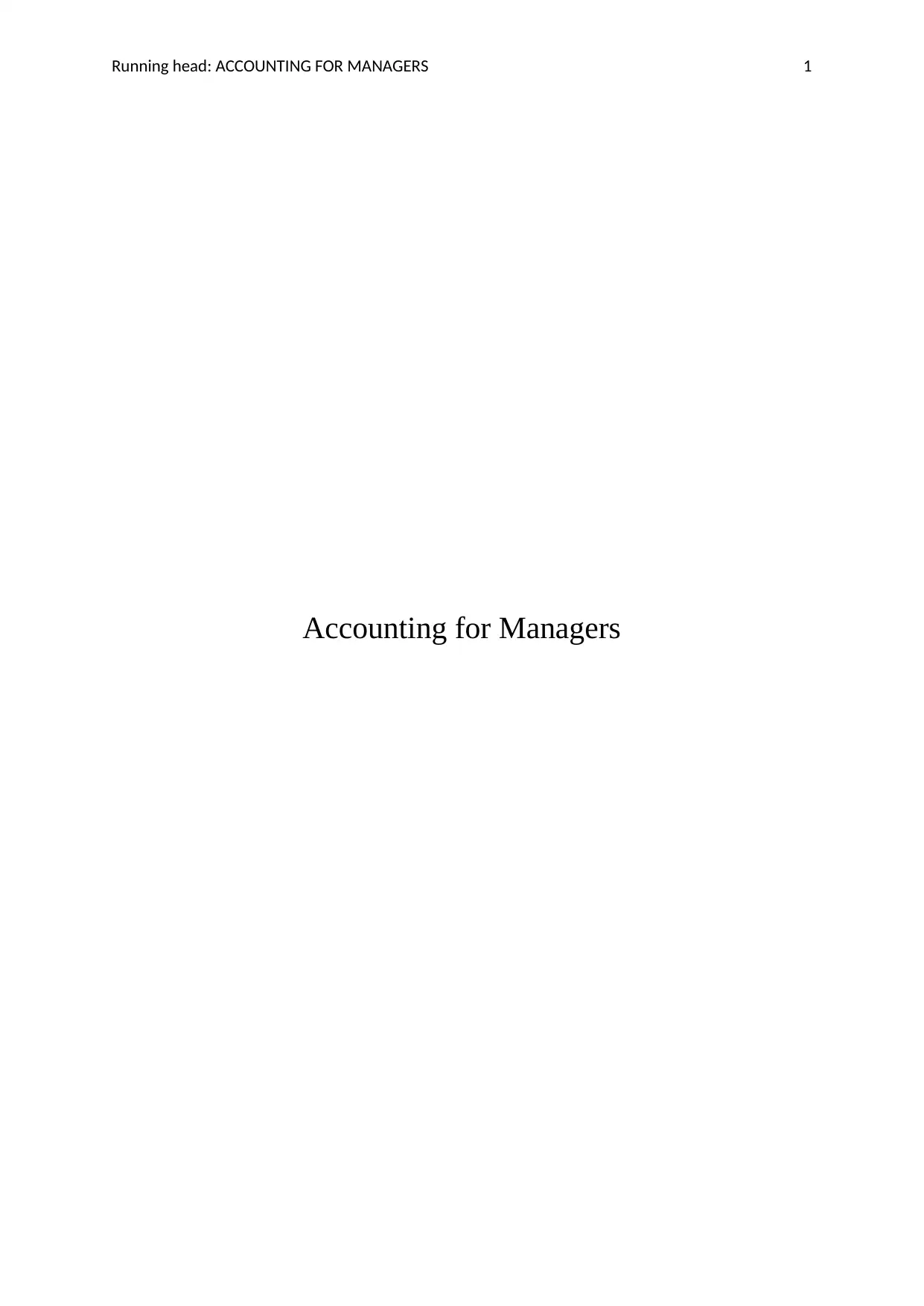
Running head: ACCOUNTING FOR MANAGERS 1
Accounting for Managers
Accounting for Managers
Paraphrase This Document
Need a fresh take? Get an instant paraphrase of this document with our AI Paraphraser
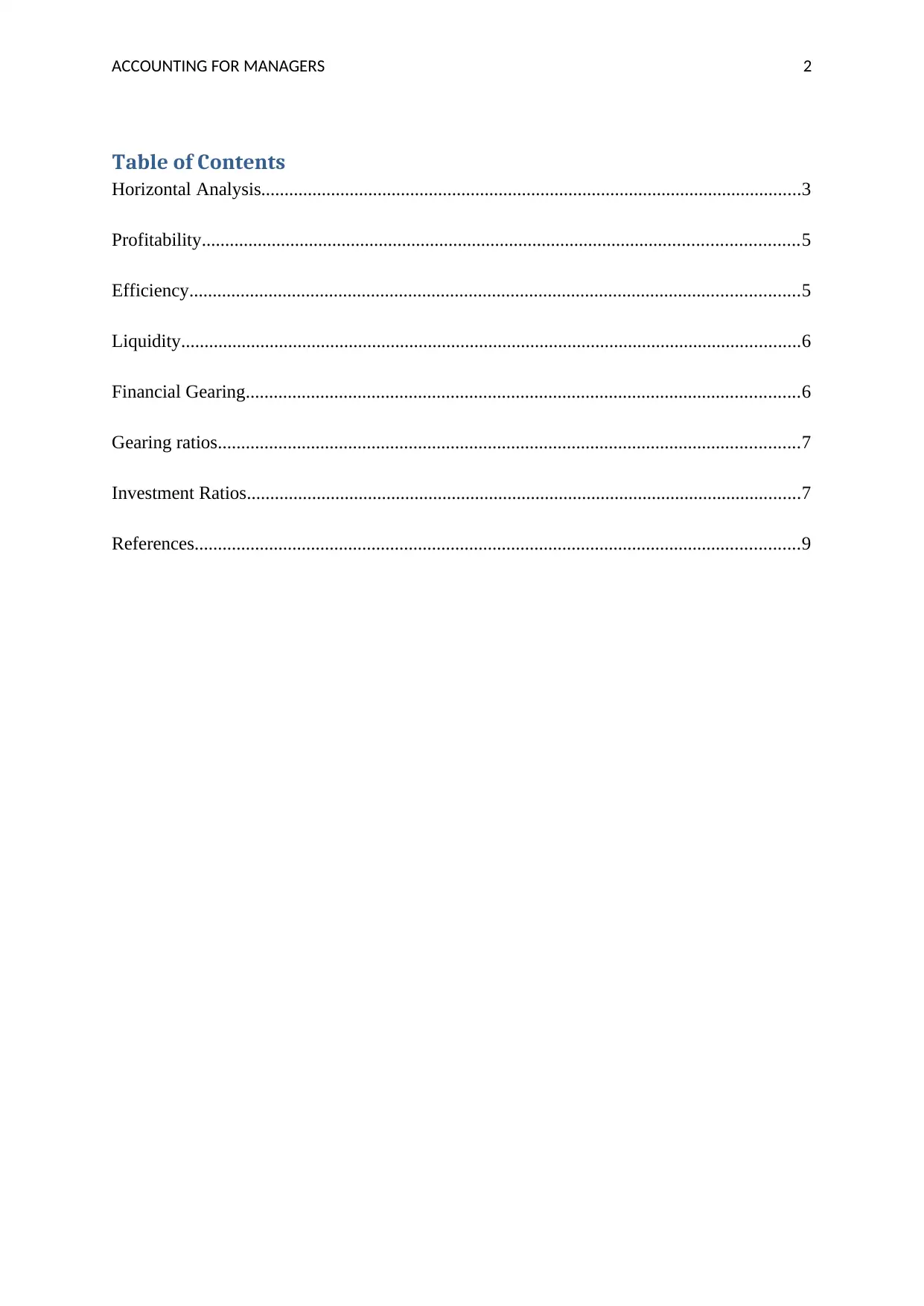
ACCOUNTING FOR MANAGERS 2
Table of Contents
Horizontal Analysis....................................................................................................................3
Profitability................................................................................................................................5
Efficiency...................................................................................................................................5
Liquidity.....................................................................................................................................6
Financial Gearing.......................................................................................................................6
Gearing ratios.............................................................................................................................7
Investment Ratios.......................................................................................................................7
References..................................................................................................................................9
Table of Contents
Horizontal Analysis....................................................................................................................3
Profitability................................................................................................................................5
Efficiency...................................................................................................................................5
Liquidity.....................................................................................................................................6
Financial Gearing.......................................................................................................................6
Gearing ratios.............................................................................................................................7
Investment Ratios.......................................................................................................................7
References..................................................................................................................................9
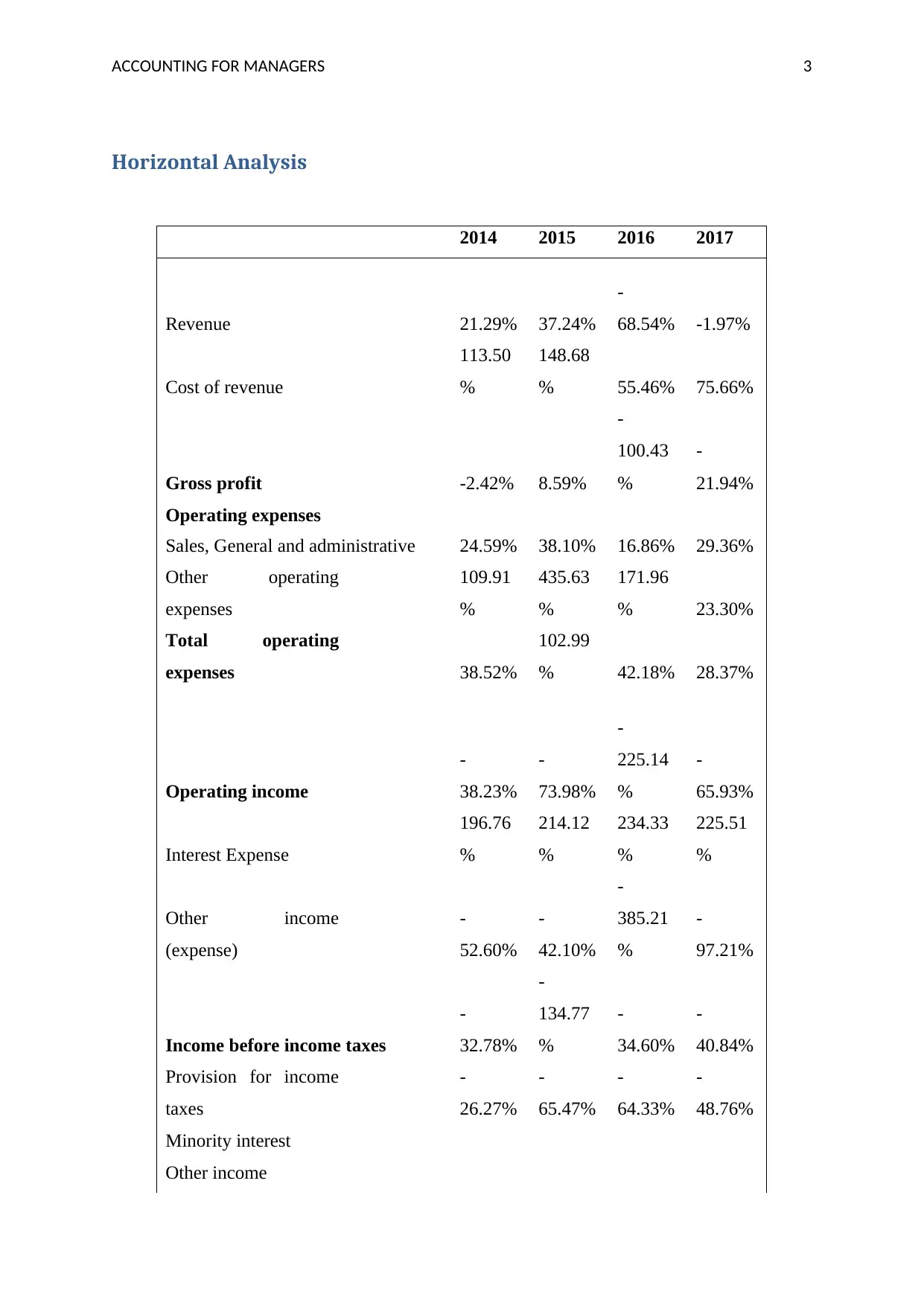
ACCOUNTING FOR MANAGERS 3
Horizontal Analysis
2014 2015 2016 2017
Revenue 21.29% 37.24%
-
68.54% -1.97%
Cost of revenue
113.50
%
148.68
% 55.46% 75.66%
Gross profit -2.42% 8.59%
-
100.43
%
-
21.94%
Operating expenses
Sales, General and administrative 24.59% 38.10% 16.86% 29.36%
Other operating
expenses
109.91
%
435.63
%
171.96
% 23.30%
Total operating
expenses 38.52%
102.99
% 42.18% 28.37%
Operating income
-
38.23%
-
73.98%
-
225.14
%
-
65.93%
Interest Expense
196.76
%
214.12
%
234.33
%
225.51
%
Other income
(expense)
-
52.60%
-
42.10%
-
385.21
%
-
97.21%
Income before income taxes
-
32.78%
-
134.77
%
-
34.60%
-
40.84%
Provision for income
taxes
-
26.27%
-
65.47%
-
64.33%
-
48.76%
Minority interest
Other income
Horizontal Analysis
2014 2015 2016 2017
Revenue 21.29% 37.24%
-
68.54% -1.97%
Cost of revenue
113.50
%
148.68
% 55.46% 75.66%
Gross profit -2.42% 8.59%
-
100.43
%
-
21.94%
Operating expenses
Sales, General and administrative 24.59% 38.10% 16.86% 29.36%
Other operating
expenses
109.91
%
435.63
%
171.96
% 23.30%
Total operating
expenses 38.52%
102.99
% 42.18% 28.37%
Operating income
-
38.23%
-
73.98%
-
225.14
%
-
65.93%
Interest Expense
196.76
%
214.12
%
234.33
%
225.51
%
Other income
(expense)
-
52.60%
-
42.10%
-
385.21
%
-
97.21%
Income before income taxes
-
32.78%
-
134.77
%
-
34.60%
-
40.84%
Provision for income
taxes
-
26.27%
-
65.47%
-
64.33%
-
48.76%
Minority interest
Other income
⊘ This is a preview!⊘
Do you want full access?
Subscribe today to unlock all pages.

Trusted by 1+ million students worldwide
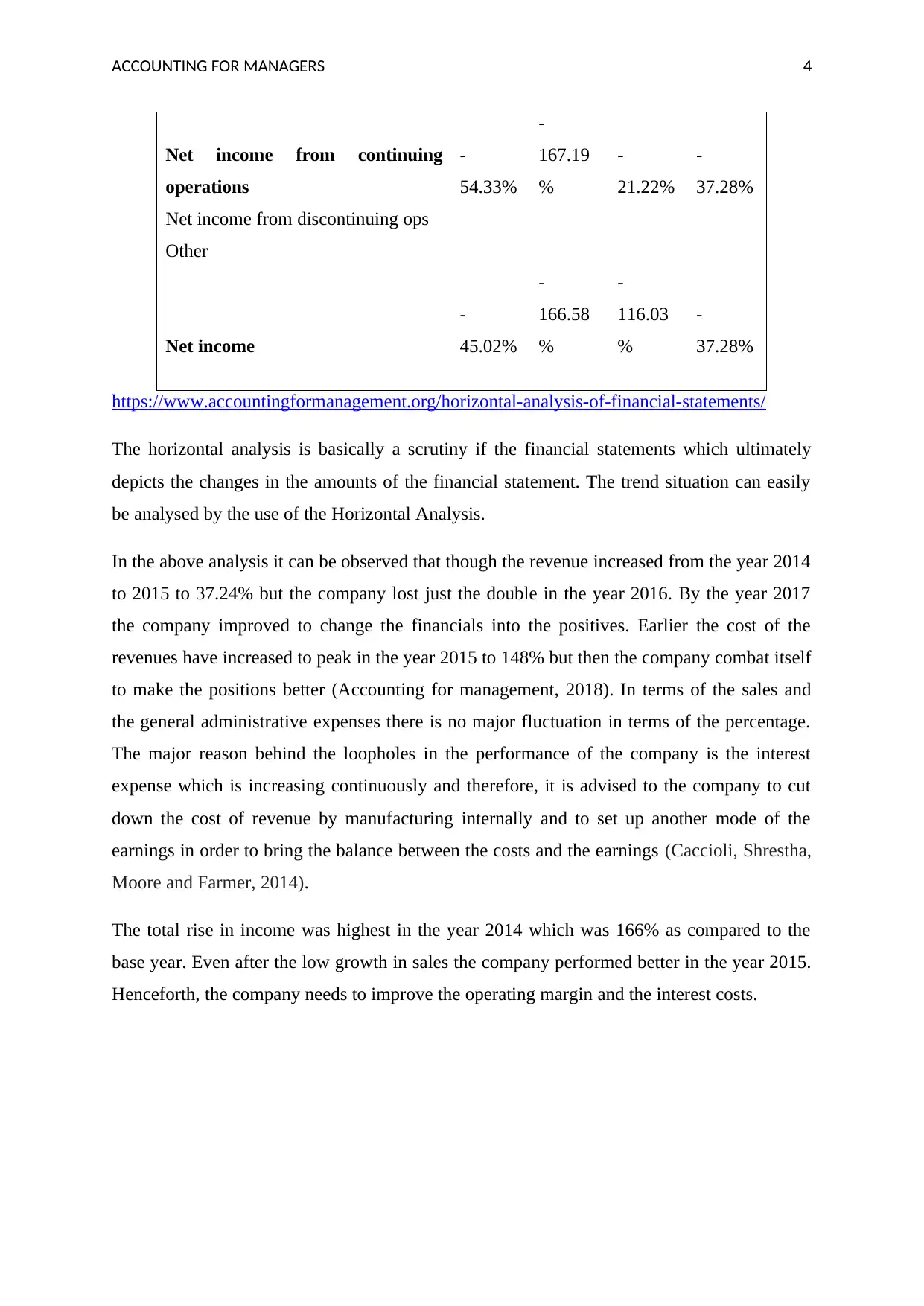
ACCOUNTING FOR MANAGERS 4
Net income from continuing
operations
-
54.33%
-
167.19
%
-
21.22%
-
37.28%
Net income from discontinuing ops
Other
Net income
-
45.02%
-
166.58
%
-
116.03
%
-
37.28%
https://www.accountingformanagement.org/horizontal-analysis-of-financial-statements/
The horizontal analysis is basically a scrutiny if the financial statements which ultimately
depicts the changes in the amounts of the financial statement. The trend situation can easily
be analysed by the use of the Horizontal Analysis.
In the above analysis it can be observed that though the revenue increased from the year 2014
to 2015 to 37.24% but the company lost just the double in the year 2016. By the year 2017
the company improved to change the financials into the positives. Earlier the cost of the
revenues have increased to peak in the year 2015 to 148% but then the company combat itself
to make the positions better (Accounting for management, 2018). In terms of the sales and
the general administrative expenses there is no major fluctuation in terms of the percentage.
The major reason behind the loopholes in the performance of the company is the interest
expense which is increasing continuously and therefore, it is advised to the company to cut
down the cost of revenue by manufacturing internally and to set up another mode of the
earnings in order to bring the balance between the costs and the earnings (Caccioli, Shrestha,
Moore and Farmer, 2014).
The total rise in income was highest in the year 2014 which was 166% as compared to the
base year. Even after the low growth in sales the company performed better in the year 2015.
Henceforth, the company needs to improve the operating margin and the interest costs.
Net income from continuing
operations
-
54.33%
-
167.19
%
-
21.22%
-
37.28%
Net income from discontinuing ops
Other
Net income
-
45.02%
-
166.58
%
-
116.03
%
-
37.28%
https://www.accountingformanagement.org/horizontal-analysis-of-financial-statements/
The horizontal analysis is basically a scrutiny if the financial statements which ultimately
depicts the changes in the amounts of the financial statement. The trend situation can easily
be analysed by the use of the Horizontal Analysis.
In the above analysis it can be observed that though the revenue increased from the year 2014
to 2015 to 37.24% but the company lost just the double in the year 2016. By the year 2017
the company improved to change the financials into the positives. Earlier the cost of the
revenues have increased to peak in the year 2015 to 148% but then the company combat itself
to make the positions better (Accounting for management, 2018). In terms of the sales and
the general administrative expenses there is no major fluctuation in terms of the percentage.
The major reason behind the loopholes in the performance of the company is the interest
expense which is increasing continuously and therefore, it is advised to the company to cut
down the cost of revenue by manufacturing internally and to set up another mode of the
earnings in order to bring the balance between the costs and the earnings (Caccioli, Shrestha,
Moore and Farmer, 2014).
The total rise in income was highest in the year 2014 which was 166% as compared to the
base year. Even after the low growth in sales the company performed better in the year 2015.
Henceforth, the company needs to improve the operating margin and the interest costs.
Paraphrase This Document
Need a fresh take? Get an instant paraphrase of this document with our AI Paraphraser

ACCOUNTING FOR MANAGERS 5
Profitability
Profitability ratios are a kind of the measurement indicators that are used to assess the ability
of the business to generate relative earnings along with the expenses (Tracy, 2012).
Operating profit Margin 17.5% 9.7% -4.4% 36.4% 10.6%
EBIT * 100
Sales
2013 2014 2015 2016 2017
Gross profit margin
79.55
%
64.00
%
62.94
% -1.08%
63.35
%
Gross profit
Sales
As per the above calculations for the year 2013 to 2017, the performance of the company in
terms of gross margin have relatively decreased and on the and also it can be observed that in
the year 2016 the margin is negative as the cost of revenue is much higher than the sales
value (Vogel, 2014) . The possible reason is decline in the sales and the overhead costs have
been increased. Therefore the company needs to focus on the cost of revenue in the later
periods.
Efficiency
The efficiency ratio basically determines the ability of the company to keep a management
and alignment between the assets and the liabilities of the company (Warren & Jones, 2018).
Inventories turnover period 2013 2014 2015 2016 2017
Inventory * 365 142.80 78.49 72.98 74.27 78.34
Cost of goods sold
Settlement period of debtors 2013 2014 2015 2016 2017
Trade debtors *365 839.39 482.76 390.11 489.48 356.42
Revenue
2013 2014 2015 2016 2017
Profitability
Profitability ratios are a kind of the measurement indicators that are used to assess the ability
of the business to generate relative earnings along with the expenses (Tracy, 2012).
Operating profit Margin 17.5% 9.7% -4.4% 36.4% 10.6%
EBIT * 100
Sales
2013 2014 2015 2016 2017
Gross profit margin
79.55
%
64.00
%
62.94
% -1.08%
63.35
%
Gross profit
Sales
As per the above calculations for the year 2013 to 2017, the performance of the company in
terms of gross margin have relatively decreased and on the and also it can be observed that in
the year 2016 the margin is negative as the cost of revenue is much higher than the sales
value (Vogel, 2014) . The possible reason is decline in the sales and the overhead costs have
been increased. Therefore the company needs to focus on the cost of revenue in the later
periods.
Efficiency
The efficiency ratio basically determines the ability of the company to keep a management
and alignment between the assets and the liabilities of the company (Warren & Jones, 2018).
Inventories turnover period 2013 2014 2015 2016 2017
Inventory * 365 142.80 78.49 72.98 74.27 78.34
Cost of goods sold
Settlement period of debtors 2013 2014 2015 2016 2017
Trade debtors *365 839.39 482.76 390.11 489.48 356.42
Revenue
2013 2014 2015 2016 2017
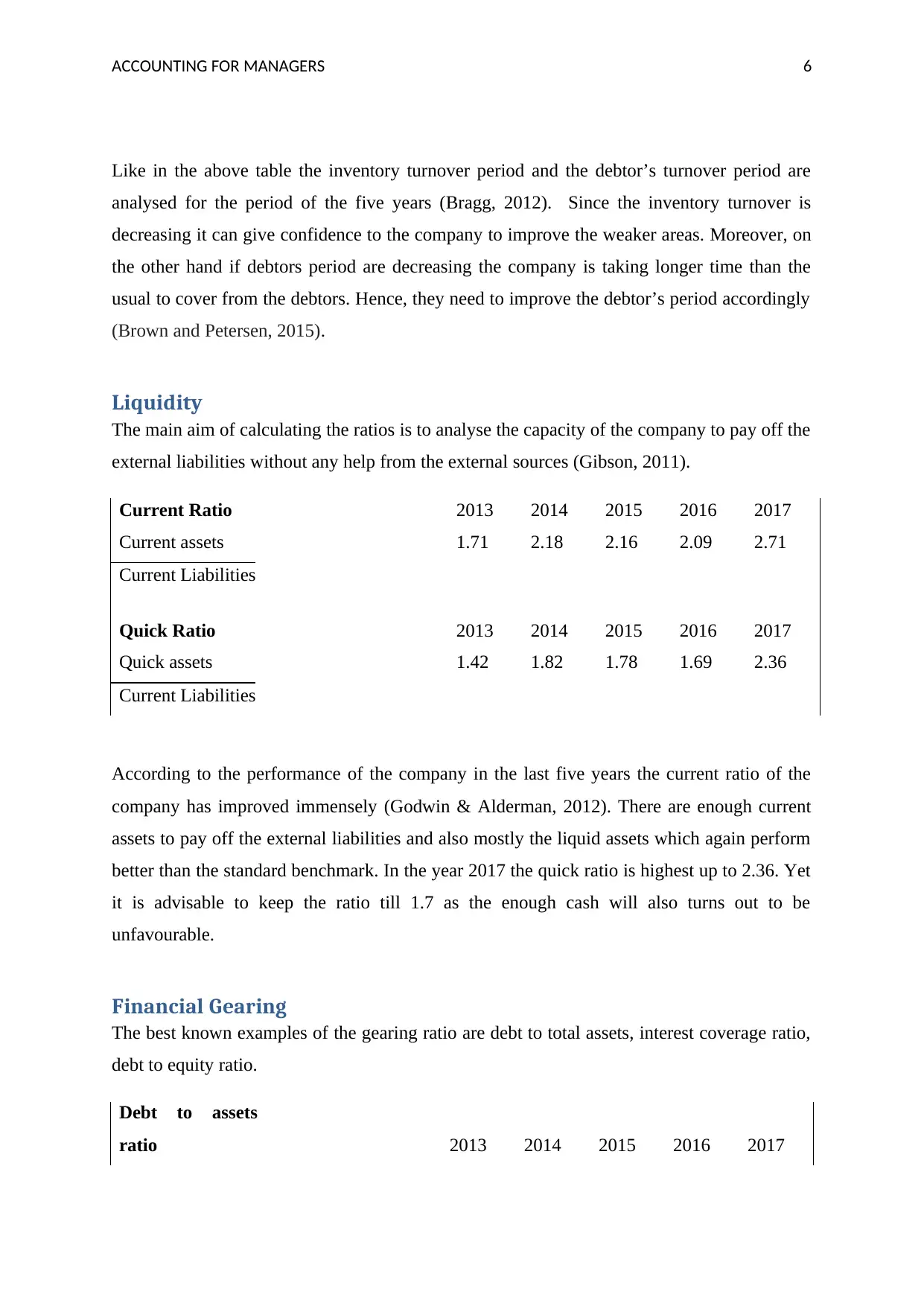
ACCOUNTING FOR MANAGERS 6
Like in the above table the inventory turnover period and the debtor’s turnover period are
analysed for the period of the five years (Bragg, 2012). Since the inventory turnover is
decreasing it can give confidence to the company to improve the weaker areas. Moreover, on
the other hand if debtors period are decreasing the company is taking longer time than the
usual to cover from the debtors. Hence, they need to improve the debtor’s period accordingly
(Brown and Petersen, 2015).
Liquidity
The main aim of calculating the ratios is to analyse the capacity of the company to pay off the
external liabilities without any help from the external sources (Gibson, 2011).
Current Ratio 2013 2014 2015 2016 2017
Current assets 1.71 2.18 2.16 2.09 2.71
Current Liabilities
Quick Ratio 2013 2014 2015 2016 2017
Quick assets 1.42 1.82 1.78 1.69 2.36
Current Liabilities
According to the performance of the company in the last five years the current ratio of the
company has improved immensely (Godwin & Alderman, 2012). There are enough current
assets to pay off the external liabilities and also mostly the liquid assets which again perform
better than the standard benchmark. In the year 2017 the quick ratio is highest up to 2.36. Yet
it is advisable to keep the ratio till 1.7 as the enough cash will also turns out to be
unfavourable.
Financial Gearing
The best known examples of the gearing ratio are debt to total assets, interest coverage ratio,
debt to equity ratio.
Debt to assets
ratio 2013 2014 2015 2016 2017
Like in the above table the inventory turnover period and the debtor’s turnover period are
analysed for the period of the five years (Bragg, 2012). Since the inventory turnover is
decreasing it can give confidence to the company to improve the weaker areas. Moreover, on
the other hand if debtors period are decreasing the company is taking longer time than the
usual to cover from the debtors. Hence, they need to improve the debtor’s period accordingly
(Brown and Petersen, 2015).
Liquidity
The main aim of calculating the ratios is to analyse the capacity of the company to pay off the
external liabilities without any help from the external sources (Gibson, 2011).
Current Ratio 2013 2014 2015 2016 2017
Current assets 1.71 2.18 2.16 2.09 2.71
Current Liabilities
Quick Ratio 2013 2014 2015 2016 2017
Quick assets 1.42 1.82 1.78 1.69 2.36
Current Liabilities
According to the performance of the company in the last five years the current ratio of the
company has improved immensely (Godwin & Alderman, 2012). There are enough current
assets to pay off the external liabilities and also mostly the liquid assets which again perform
better than the standard benchmark. In the year 2017 the quick ratio is highest up to 2.36. Yet
it is advisable to keep the ratio till 1.7 as the enough cash will also turns out to be
unfavourable.
Financial Gearing
The best known examples of the gearing ratio are debt to total assets, interest coverage ratio,
debt to equity ratio.
Debt to assets
ratio 2013 2014 2015 2016 2017
⊘ This is a preview!⊘
Do you want full access?
Subscribe today to unlock all pages.

Trusted by 1+ million students worldwide

ACCOUNTING FOR MANAGERS 7
Debt 0.000 0.156 0.150 0.150 0.153
Total assets
Interest coverage ratio 2013 2014 2015 2016 2017
EBIT 16.61 3.76 -1.84 3.25 3.02
Interest Expense
Gearing ratios
The gearing ratio is the measure that demonstrates the degree of the firm’s operations which
is funded by the combination of the equity as well as the debt. A company may have a ratio
of the 0.6 but still it will vary from the industry’s average (Higgins, 2012). If the computation
is less than 1, it means the company isn’t making enough money to pay its interest payments
and vice versa the company is able to pay the interest obligations easily with enough cash
left. The company though have failed dot achieve the standard in the year 2015 yet it
improved in the year 2016 but in the last year again the company is facing issues. Therefore,
the company shall cut down the interest expenses (Jenter & Lewellen, 2015).
Investment Ratios
The investment ratios are the performance drivers of the company. The company assess the
price earnings ratio, the dividend yield ratio. These ratios are majorly in the interest of the
investors, analysts and the competitors (Law, 2018).
In essence the price earnings ratio is the indicator of the company’s earnings against the one
dollar. A higher P/E ratio suggests the investors are expecting the higher earnings growth.
Price earnings
ratio
Price per share 1.07 1.08 0.7 0.44 0.39
Price per share 0.79 1.79 -0.83 0.41 0.49
EPS
Dividend yield
Annual dividend 0.375 0.04 0.04 0.02 0.01
Annual dividend 48% 2% -5% 5% 2%
Debt 0.000 0.156 0.150 0.150 0.153
Total assets
Interest coverage ratio 2013 2014 2015 2016 2017
EBIT 16.61 3.76 -1.84 3.25 3.02
Interest Expense
Gearing ratios
The gearing ratio is the measure that demonstrates the degree of the firm’s operations which
is funded by the combination of the equity as well as the debt. A company may have a ratio
of the 0.6 but still it will vary from the industry’s average (Higgins, 2012). If the computation
is less than 1, it means the company isn’t making enough money to pay its interest payments
and vice versa the company is able to pay the interest obligations easily with enough cash
left. The company though have failed dot achieve the standard in the year 2015 yet it
improved in the year 2016 but in the last year again the company is facing issues. Therefore,
the company shall cut down the interest expenses (Jenter & Lewellen, 2015).
Investment Ratios
The investment ratios are the performance drivers of the company. The company assess the
price earnings ratio, the dividend yield ratio. These ratios are majorly in the interest of the
investors, analysts and the competitors (Law, 2018).
In essence the price earnings ratio is the indicator of the company’s earnings against the one
dollar. A higher P/E ratio suggests the investors are expecting the higher earnings growth.
Price earnings
ratio
Price per share 1.07 1.08 0.7 0.44 0.39
Price per share 0.79 1.79 -0.83 0.41 0.49
EPS
Dividend yield
Annual dividend 0.375 0.04 0.04 0.02 0.01
Annual dividend 48% 2% -5% 5% 2%
Paraphrase This Document
Need a fresh take? Get an instant paraphrase of this document with our AI Paraphraser
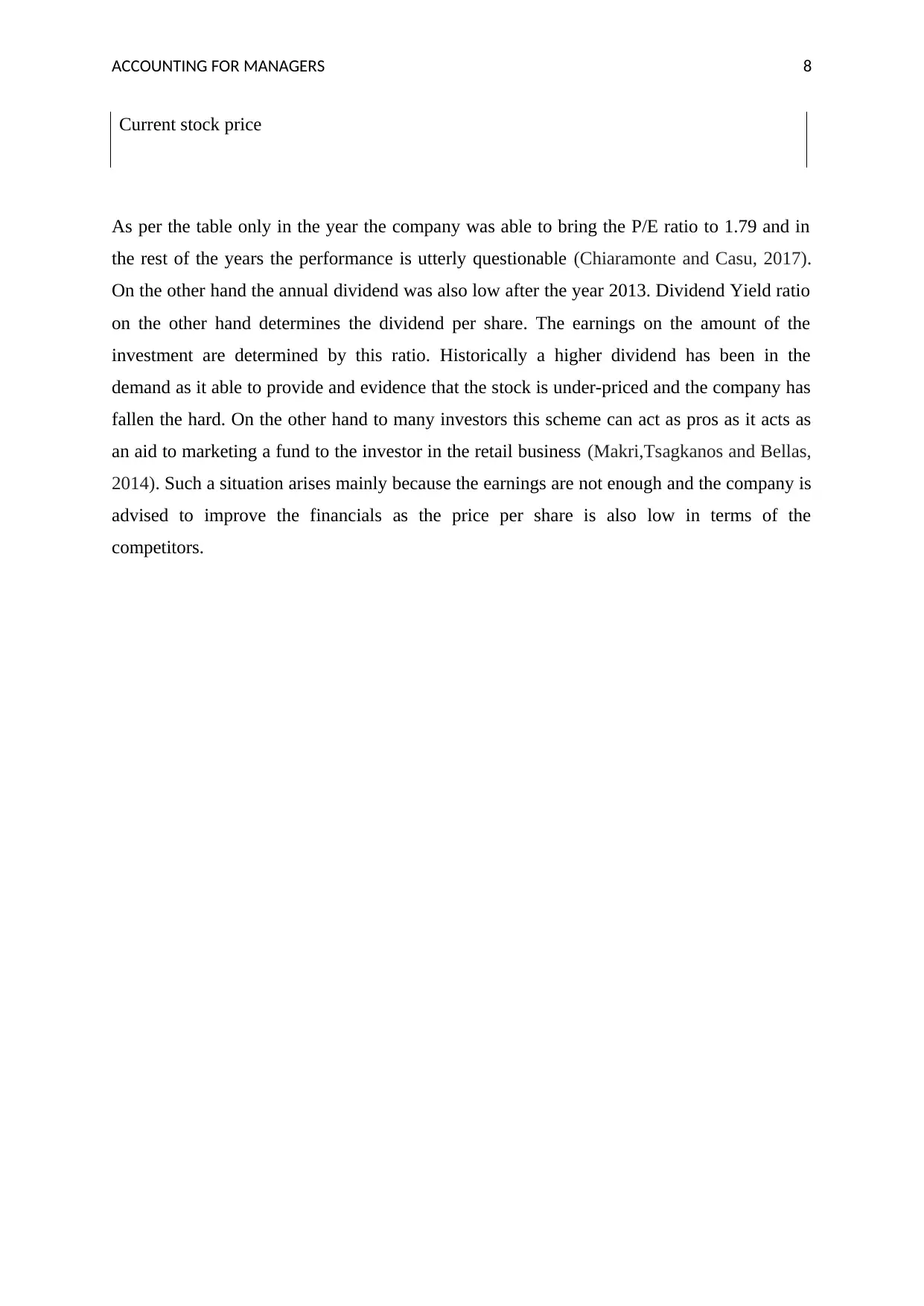
ACCOUNTING FOR MANAGERS 8
Current stock price
As per the table only in the year the company was able to bring the P/E ratio to 1.79 and in
the rest of the years the performance is utterly questionable (Chiaramonte and Casu, 2017).
On the other hand the annual dividend was also low after the year 2013. Dividend Yield ratio
on the other hand determines the dividend per share. The earnings on the amount of the
investment are determined by this ratio. Historically a higher dividend has been in the
demand as it able to provide and evidence that the stock is under-priced and the company has
fallen the hard. On the other hand to many investors this scheme can act as pros as it acts as
an aid to marketing a fund to the investor in the retail business (Makri,Tsagkanos and Bellas,
2014). Such a situation arises mainly because the earnings are not enough and the company is
advised to improve the financials as the price per share is also low in terms of the
competitors.
Current stock price
As per the table only in the year the company was able to bring the P/E ratio to 1.79 and in
the rest of the years the performance is utterly questionable (Chiaramonte and Casu, 2017).
On the other hand the annual dividend was also low after the year 2013. Dividend Yield ratio
on the other hand determines the dividend per share. The earnings on the amount of the
investment are determined by this ratio. Historically a higher dividend has been in the
demand as it able to provide and evidence that the stock is under-priced and the company has
fallen the hard. On the other hand to many investors this scheme can act as pros as it acts as
an aid to marketing a fund to the investor in the retail business (Makri,Tsagkanos and Bellas,
2014). Such a situation arises mainly because the earnings are not enough and the company is
advised to improve the financials as the price per share is also low in terms of the
competitors.
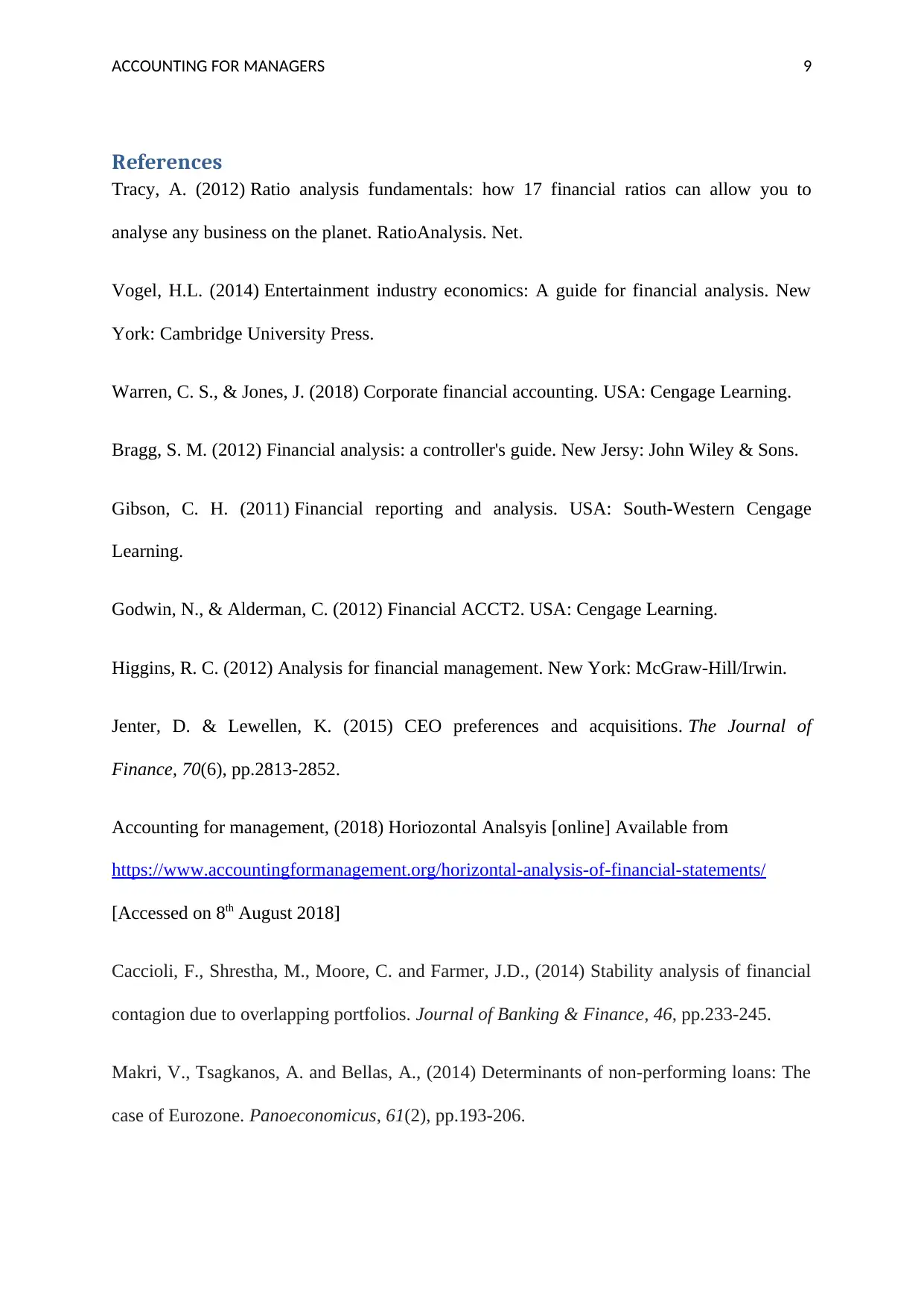
ACCOUNTING FOR MANAGERS 9
References
Tracy, A. (2012) Ratio analysis fundamentals: how 17 financial ratios can allow you to
analyse any business on the planet. RatioAnalysis. Net.
Vogel, H.L. (2014) Entertainment industry economics: A guide for financial analysis. New
York: Cambridge University Press.
Warren, C. S., & Jones, J. (2018) Corporate financial accounting. USA: Cengage Learning.
Bragg, S. M. (2012) Financial analysis: a controller's guide. New Jersy: John Wiley & Sons.
Gibson, C. H. (2011) Financial reporting and analysis. USA: South-Western Cengage
Learning.
Godwin, N., & Alderman, C. (2012) Financial ACCT2. USA: Cengage Learning.
Higgins, R. C. (2012) Analysis for financial management. New York: McGraw-Hill/Irwin.
Jenter, D. & Lewellen, K. (2015) CEO preferences and acquisitions. The Journal of
Finance, 70(6), pp.2813-2852.
Accounting for management, (2018) Horiozontal Analsyis [online] Available from
https://www.accountingformanagement.org/horizontal-analysis-of-financial-statements/
[Accessed on 8th August 2018]
Caccioli, F., Shrestha, M., Moore, C. and Farmer, J.D., (2014) Stability analysis of financial
contagion due to overlapping portfolios. Journal of Banking & Finance, 46, pp.233-245.
Makri, V., Tsagkanos, A. and Bellas, A., (2014) Determinants of non-performing loans: The
case of Eurozone. Panoeconomicus, 61(2), pp.193-206.
References
Tracy, A. (2012) Ratio analysis fundamentals: how 17 financial ratios can allow you to
analyse any business on the planet. RatioAnalysis. Net.
Vogel, H.L. (2014) Entertainment industry economics: A guide for financial analysis. New
York: Cambridge University Press.
Warren, C. S., & Jones, J. (2018) Corporate financial accounting. USA: Cengage Learning.
Bragg, S. M. (2012) Financial analysis: a controller's guide. New Jersy: John Wiley & Sons.
Gibson, C. H. (2011) Financial reporting and analysis. USA: South-Western Cengage
Learning.
Godwin, N., & Alderman, C. (2012) Financial ACCT2. USA: Cengage Learning.
Higgins, R. C. (2012) Analysis for financial management. New York: McGraw-Hill/Irwin.
Jenter, D. & Lewellen, K. (2015) CEO preferences and acquisitions. The Journal of
Finance, 70(6), pp.2813-2852.
Accounting for management, (2018) Horiozontal Analsyis [online] Available from
https://www.accountingformanagement.org/horizontal-analysis-of-financial-statements/
[Accessed on 8th August 2018]
Caccioli, F., Shrestha, M., Moore, C. and Farmer, J.D., (2014) Stability analysis of financial
contagion due to overlapping portfolios. Journal of Banking & Finance, 46, pp.233-245.
Makri, V., Tsagkanos, A. and Bellas, A., (2014) Determinants of non-performing loans: The
case of Eurozone. Panoeconomicus, 61(2), pp.193-206.
⊘ This is a preview!⊘
Do you want full access?
Subscribe today to unlock all pages.

Trusted by 1+ million students worldwide
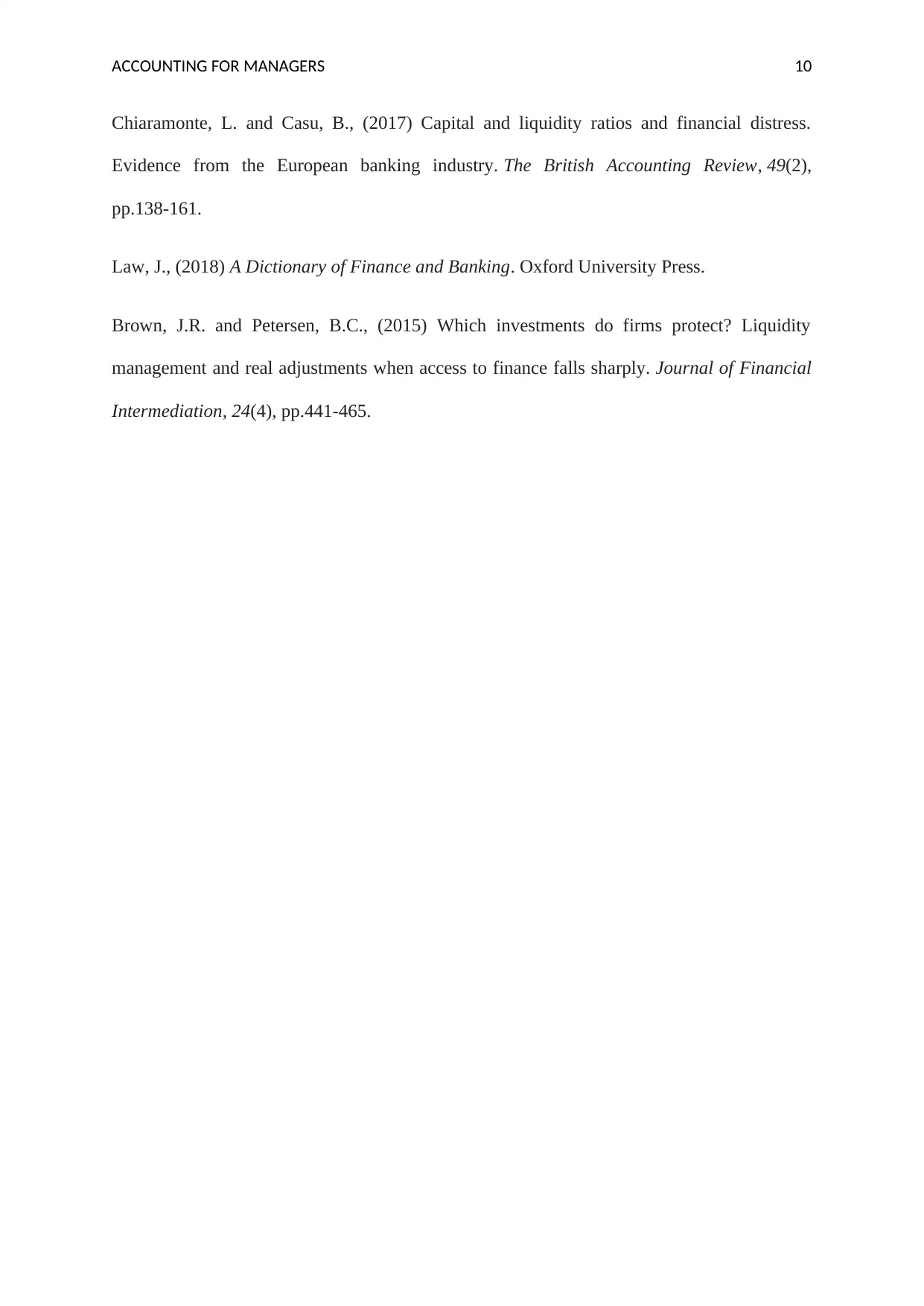
ACCOUNTING FOR MANAGERS 10
Chiaramonte, L. and Casu, B., (2017) Capital and liquidity ratios and financial distress.
Evidence from the European banking industry. The British Accounting Review, 49(2),
pp.138-161.
Law, J., (2018) A Dictionary of Finance and Banking. Oxford University Press.
Brown, J.R. and Petersen, B.C., (2015) Which investments do firms protect? Liquidity
management and real adjustments when access to finance falls sharply. Journal of Financial
Intermediation, 24(4), pp.441-465.
Chiaramonte, L. and Casu, B., (2017) Capital and liquidity ratios and financial distress.
Evidence from the European banking industry. The British Accounting Review, 49(2),
pp.138-161.
Law, J., (2018) A Dictionary of Finance and Banking. Oxford University Press.
Brown, J.R. and Petersen, B.C., (2015) Which investments do firms protect? Liquidity
management and real adjustments when access to finance falls sharply. Journal of Financial
Intermediation, 24(4), pp.441-465.
1 out of 10
Related Documents
Your All-in-One AI-Powered Toolkit for Academic Success.
+13062052269
info@desklib.com
Available 24*7 on WhatsApp / Email
![[object Object]](/_next/static/media/star-bottom.7253800d.svg)
Unlock your academic potential
Copyright © 2020–2025 A2Z Services. All Rights Reserved. Developed and managed by ZUCOL.



